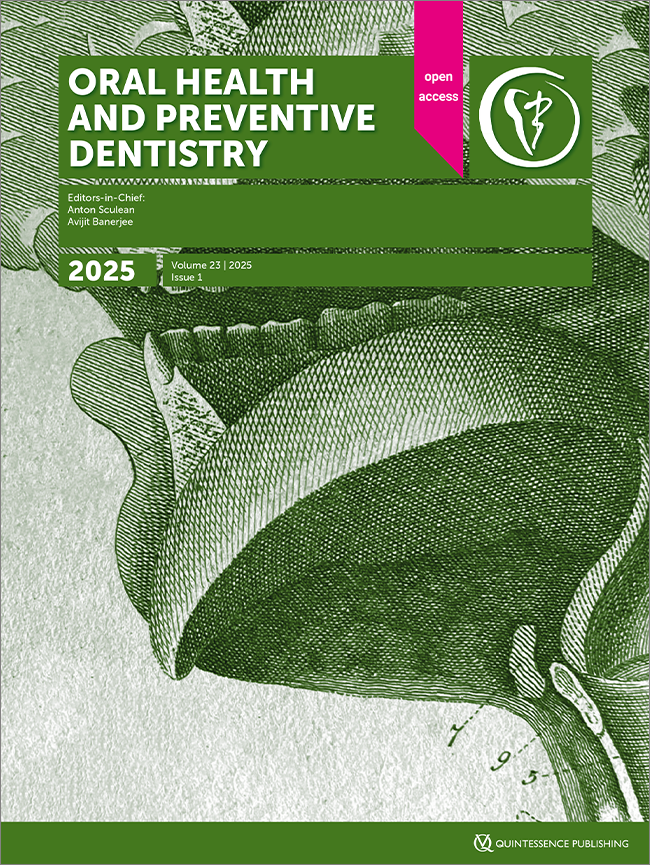Oral Health and Preventive Dentistry, 1/2023
Acceso libre Sólo en líneaID de PubMed (PMID): 37345581junio 22, 2023,Páginas 1, Idioma: InglésSculean, Anton / Banerjee, Avijit / Rothenbücher, MarinaThe Journal of Adhesive Dentistry, 1/2021
DOI: 10.3290/j.jad.b916831, ID de PubMed (PMID): 33512115Páginas 47-56, Idioma: InglésOrtiz-Ruiz, Antonio José / Martínez-Marco, José Francisco / Pérez-Silva, Amparo / Serna-Muñoz, Clara / Cabello, Inmaculada / Banerjee, AvijitPurpose: To study the effect of the varnish type, application time and surface polishing on the shear bond strength (SBS) of a universal adhesive in healthy and demineralized bovine enamel.
Materials and Methods: 432 bovine primary central incisors were assigned to 18 groups according to enamel mineralization [healthy and demineralized], topical varnish [Clinpro White Varnish (CWV; 3M Oral Care) and Profluorid (PFV, Voco)], remineralization time [24 h or 21 days] and polishing or not of the enamel surface. Adhesion was tested using Futurabond M (Voco)+ and GrandioSO (Voco). Sheer bond strength (SBS) was measured and the fracture mode studied. The statistical analysis was performed using two-way ANOVA, Tukey’s test, and Pearson’s chi-squared test.
Results: In healthy bovine enamel, CWV reduced SBS at 24 h and 21 days; polishing significantly improved SBS. PFV increased SBS in healthy enamel at 21 days and demineralized enamel at 24 h and 21 days; polishing had no effect on SBS. The application time and polishing of the enamel surface affected the behavior of varnishes with respect to SBS. There was a correlation between the type of fracture and the degree of mineralization as well as the timepoint of varnish application.
Conclusions: Remineralization of demineralized enamel with fluoride varnishes permits the recovery of the bond strength obtained in healthy enamel. Of the two varnishes studied, PFV had the highest SBS and more uniform behavior, regardless of the application timepoint, degree of mineralization, and surface treatment of the enamel.
Palabras clave: demineralization, enamel, remineralization, fluoride varnish, tricalcium phosphate, shear bond strength
Oral Health and Preventive Dentistry, 1/2020
Acceso libre Sólo en líneaEditorialDOI: 10.3290/j.ohpd.b871931diciembre 15, 2020,Páginas 1-2, Idioma: InglésBanerjee, Avijit / Sculean, Anton / Petersen, Poul ErikSummary: Oral/dental healthcare delivery in the post-pandemic era will be different, with challenges to overcome and positive opportunities to take. Managing the needs, wants and expectations of all stakeholders must be communicated and actioned effectively, moving forwards. It is the responsibility of all stakeholders to work together to help provide high quality, evidence-based pragmatic oral healthcare delivery for the future. Patient-focused, team-delivered, minimum intervention oral healthcare (MIOC) is applicable to all patients at all stages of their lives and underpins long-term delivery of better oral and systemic health to all. Guidance, peer-support, whole-team training along with agile commissioning and suitable incentivisation will need to support the paradigm shift to prevention-based MIOC clinical practice.
Palabras clave: Covid-19, dentistry, minimally invasive dentistry, minimum/minimal intervention, oral healthcare, pandemic
Oral Health and Preventive Dentistry, 5/2018
DOI: 10.3290/j.ohpd.a41364, ID de PubMed (PMID): 30460355Páginas 425-429, Idioma: InglésArrifin, Azirrawani / Heidari, Ellie / Burke, Mary / Fenlon, Michael R. / Banerjee, AvijitPurpose: Radiotherapy causes xerostomia in patients treated for head and neck cancer. This study investigated changes in quality and quantity of saliva after radiotherapy and possible associations between these changes and alterations in oral flora.
Materials and Methods: The study was a prospective cohort study of patients receiving radiotherapy for head and neck cancer. Suitable patients were recruited before treatment commenced, and informed consent was obtained. Patients were examined, and provided unstimulated and stimulated saliva samples. Quantity of saliva, buffering capacity and pH were measured. Oral flora was cultured from the saliva samples. Oral clearance of glucose and of lactose was measured. These interventions were repeated at intervals after radiotherapy had been completed.
Results: Eighteen patients were recruited. Stimulated and unstimulated saliva flow rates, glucose clearance, salivary pH and buffering capacity were significantly reduced after radiotherapy. Candida albicans counts were significantly increased. These increases were significantly correlated with reductions in stimulated and unstimulated salivary flow rates. Counts of lactobacilli, Streptococcus mutans and Bifidobacteriaceae increased, but not statistically significantly.
Conclusions: Therapeutic radiotherapy significantly reduced the quality and quantity of saliva in head and neck cancer patients. These reductions were associated with increased C. albicans counts.
Palabras clave: cancer microflora, quality of life, radiotherapy, saliva, xerostomia
Oral Health and Preventive Dentistry, 1/2018
DOI: 10.3290/j.ohpd.a39822, ID de PubMed (PMID): 29459904Páginas 21-25, Idioma: InglésMilly, Hussam / Banerjee, AvijitPurpose: To clinically examine the effect of the type of ight-curing unit on the light intensity output and to assess different operator variables which affect light curing of photo-initiated restorative dental materials, in Damascus, Syria.
Materials and Methods: A total of 185 private dental practices in the Damascus area were visited to invite the clinicians to participate in this study. The intensity of 163 light-curing units (LCUs) was assessed by radiometry in a standard protocol. The age of the curing unit, light tip direction, distance from restoration surface, time of exposure and the presence of adherent composite remnants on the tip of the light pipe were assessed. Independent samples t-tests and ANOVA with Bonferroni post-hoc tests were conducted (p = 0.05).
Results: The light intensity was affected significantly by the type of the LCU (p 0.001). The increased age of light-curing units significantly reduced the emitted light intensity in LED and QTH units (p 0.05). The presence of adherent resin composite remnants on the pipe tip of the curing unit was monitored in 74 cases out of 163 (45%). The disinfection wipe was the most common method used to ensure infection control of the curing units.
Conclusion: LED units exhibited a significantly better light intensity output at the tip when compared to the QTH units. It is important for dentists to consider all practical aspects which can influence the efficacy of LCUs in daily practice.
Palabras clave: halogen, LED, light-curing unit, light-emitting diode, light intensity, photocuring
Oral Health and Preventive Dentistry, 1/2016
DOI: 10.3290/j.ohpd.a35643, ID de PubMed (PMID): 26904752Páginas 3-4, Idioma: InglésSculean, Anton / Banerjee, Avijit / Petersen, Poul Erik




